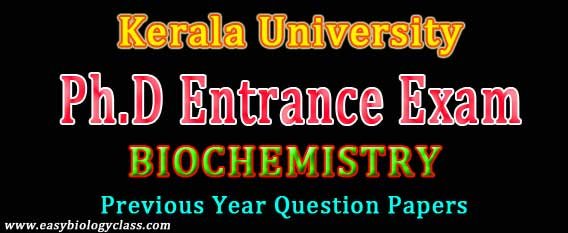
KERALA UNIVERSITY Ph.D. ENTRANCE EXAMINATION – 2013
FACULTY OF SCIENCES
BIOCHEMISTRY
Time: 140 Minutes Maximum Marks: 160
Note: Answer any twelve questions from Section B and one question from Section C in the subject concerned. In Section B, each question carries 10 marks. Section C carries 40 marks. In Section B an answer should not exceed 100 words. In Section C, an answer should not exceed 500 words.
SECTION – B
(1). Explain the term Chromatography. How are proteins separated by :
a. Affinity Chromatography
b. Ion-exchange chromatography.
(2). Given a mixture of proteins which contains a recombinant insulin among other proteins which of the above two chromatographic technique will you employ for purification of the insulin molecule. Why?
(3). Explain Beer Lamberts’s law. Describe an experiment to verify this law. Given that the Molar extinction coefficient of a compound in water is 25,000 at 550 nm and a solution of this compound in water gave an absorbance of 0.552 at 550 nm calculate the concentration of the compound.
(4). Explain the importance of-SH functional groups in stabilizing structure of proteins.
(5). Explain the principle of density gradient centrifugation and describe how this technique can be used in purification of cell organelles.
(6). Differentiate between colorimeter and spectrophotometers.
(7). Why should glucose be stored as glycogen rather than be stored as glucose itself. Give your explanation in terms of colloidal properties.
(8). What is the principle of Polyacrylamide gel electrophoresis?
(9). What are allosteric enzymes? Give an example and explain its role in metabolism.
(10). Identity the following by: a) Competitive b) Uncompetitive, and c) Noncompetitive inhibition, using Lineweaver-Burk plots.
(11). How does substrate concentration affect velocity of enzyme catalyzed reactions? Explain with Michaelis Menten equation.
(12). Explain the mechanism of coordinated regulation of glycolysis and gluconeogenesis, Comment on how this regulation is affected during diabetes mellitus.
(13). What are natural killer (NK) cells? How it is associated with tumor cells?
(14). Discuss the origin of the competence and progression signals required for activation and proliferation of B cells induced by (a) soluble protein antigens and (b) bacterial lipopolysaccharide (LPS).
(15). What are Monoclonal antibodies? Briefly discuss their synthesis and applications.
(16). What are multienzyme complexes? Explain with an example.
SECTION – C
(1). Substance A is consumed by a reaction that only occurs in the presence of substance B. The role of substance B is unknown (i.e., it could be a reactant or a catalyst) and the reaction that consumes A is of unknown order. The initial concentration of A is 2.0 mm and the concentration of A as a function of time is:
Time (min) [A] remaining
1 1.6
2 1.44
4 1.12
8 0.76
16 0.48
(a). Define what is meant when a reaction mechanism is called ‘firstorder’ or ‘second’.
(b). Is the consumption of A a first order reaction and how do you know explain with a graph.
(c). If not how would you repeat this experiment such that ‘first order’ kinetics would be observed and why?
(2). A peptide was found to have the following amino acid composition by acid hydrolysis: Ala, Arg, Met, Tyr, Gly, 2 Lys, Ser, Pro, Glu. On further analysis the following data was obtained :
(A). N-terminal analysis yielded Dansyl-Gly
(B). Tyrptic digestion yielded 3 peptides: T-1, T-2, and T-3
T-1 was a dipeptide and Edman degradation showed it had N-terminal Gln
T-2 was a tripeptide with amino acid composition: Lys, Gly, Ser
T-3 was a pentapeptide and Edman degradation showed it had N-terminal Lys
(C). Chymotyrptic digestion yielded 2 peptides: Ch-1 and Ch-2
Ch-1 had amino acid composition: 2 Lys, Pro, Gly, Ser Tyr
Ch-2 yielded Met when degraded by Edman method
(D). CNBr cleavage gave 2 peptides: CB-1 and CB-2
CB-1 contained homo Serlactone and had Gly as N-terminal by Edman method
CB-2 released PTH-Arg in first step of Edman and PTH-Gln in second step.
(a) What is the sequence of the peptide? Draw full chemical structure of the peptide and show its proper charges on all ionizable groups at pH 7.
(b) What is net charge on Peptide Z at pH 3 and pH 10 ? (pK values for amino acids: Gly 2.4, 9.8; Ala – 2.4, 9.9; Phe-2.2,9.2;Tyr- 2.2, 9.1; Pro- 2.0, 10.7; His-1.8, 6.0, 9.3; Glu-2.1, 4.1, 9.5; Gln 2.2, 9.1; Asp 2.0, 3.9, 9.9; Asn 2.1, 8.8; Arg 1.8, 9.0, 12.5)
(c) What is the pI of Peptide Z?
(3). Explain the principle of PCR and describe an experiment where you would use qRT-PCR for Multiplexing.
Download this Question Paper as PDF File
Download link is provided below the PDF Preview…
 Loading...
Loading...
Browse more in Easy Biology Class…
Lecture NotesBiology PPTsVideo TutorialsBiology MCQQuestion BankDifference betweenPractical AidsMock Tests (Online)Biology Exams
If you like this post, please COMMENT . . . . (below ↓)
Please Share with your Friends, Relatives, Students and Colleagues…
